import pandas as pd
import matplotlib.pyplot as plt
import seaborn as sns
%matplotlib inline
UNIQLO=pd.read_csv('L2W1.csv')
UNIQLO.head()
|
store_id |
city |
channel |
gender_group |
age_group |
wkd_ind |
product |
customer |
revenue |
order |
quant |
unit_cost |
| 0 |
658 |
深圳 |
线下 |
Female |
25-29 |
Weekday |
当季新品 |
4 |
796.0 |
4 |
4 |
59 |
| 1 |
146 |
杭州 |
线下 |
Female |
25-29 |
Weekday |
运动 |
1 |
149.0 |
1 |
1 |
49 |
| 2 |
70 |
深圳 |
线下 |
Male |
>=60 |
Weekday |
T恤 |
2 |
178.0 |
2 |
2 |
49 |
| 3 |
658 |
深圳 |
线下 |
Female |
25-29 |
Weekday |
T恤 |
1 |
59.0 |
1 |
1 |
49 |
| 4 |
229 |
深圳 |
线下 |
Male |
20-24 |
Weekend |
袜子 |
2 |
65.0 |
2 |
3 |
9 |
UNIQLO.info()
UNIQLO.describe()
RangeIndex: 22293 entries, 0 to 22292
Data columns (total 12 columns):
store_id 22293 non-null int64
city 22293 non-null object
channel 22293 non-null object
gender_group 22293 non-null object
age_group 22293 non-null object
wkd_ind 22293 non-null object
product 22293 non-null object
customer 22293 non-null int64
revenue 22293 non-null float64
order 22293 non-null int64
quant 22293 non-null int64
unit_cost 22293 non-null int64
dtypes: float64(1), int64(5), object(6)
memory usage: 2.0+ MB
|
store_id |
customer |
revenue |
order |
quant |
unit_cost |
| count |
22293.000000 |
22293.000000 |
22293.000000 |
22293.000000 |
22293.000000 |
22293.000000 |
| mean |
335.391558 |
1.629480 |
159.531371 |
1.651998 |
1.858072 |
46.124658 |
| std |
230.236167 |
1.785605 |
276.254066 |
1.861480 |
2.347301 |
19.124347 |
| min |
19.000000 |
1.000000 |
-0.660000 |
1.000000 |
1.000000 |
9.000000 |
| 25% |
142.000000 |
1.000000 |
64.000000 |
1.000000 |
1.000000 |
49.000000 |
| 50% |
315.000000 |
1.000000 |
99.000000 |
1.000000 |
1.000000 |
49.000000 |
| 75% |
480.000000 |
2.000000 |
175.000000 |
2.000000 |
2.000000 |
49.000000 |
| max |
831.000000 |
58.000000 |
12538.000000 |
65.000000 |
84.000000 |
99.000000 |
UNIQLO1 = UNIQLO[UNIQLO['revenue']>0]
UNIQLO1.describe()
|
store_id |
customer |
revenue |
order |
quant |
unit_cost |
| count |
22262.000000 |
22262.000000 |
22262.000000 |
22262.000000 |
22262.000000 |
22262.000000 |
| mean |
335.486614 |
1.630357 |
159.753549 |
1.652906 |
1.859222 |
46.127841 |
| std |
230.371454 |
1.786694 |
276.382135 |
1.862617 |
2.348723 |
19.120825 |
| min |
19.000000 |
1.000000 |
10.000000 |
1.000000 |
1.000000 |
9.000000 |
| 25% |
142.000000 |
1.000000 |
66.000000 |
1.000000 |
1.000000 |
49.000000 |
| 50% |
315.000000 |
1.000000 |
99.000000 |
1.000000 |
1.000000 |
49.000000 |
| 75% |
480.000000 |
2.000000 |
175.000000 |
2.000000 |
2.000000 |
49.000000 |
| max |
831.000000 |
58.000000 |
12538.000000 |
65.000000 |
84.000000 |
99.000000 |
问题一:整体销售情况随着时间的变化是怎样的?
题目拆解:
数据中与时间有关的字段仅为类别变量wkd_ind代表的Weekday和Weekend,即购买发生的时间是周中还是周末。本题意为分析对比周末和周中与销售有关的数据,包括产品销售数量quant、销售金额revenue、顾客人数customer的情况,可生成柱状图进行可视化。
sns.barplot(x='wkd_ind',y='quant',data =UNIQLO1)
C:\Users\LYY\Anaconda3\lib\site-packages\scipy\stats\stats.py:1713: FutureWarning: Using a non-tuple sequence for multidimensional indexing is deprecated; use `arr[tuple(seq)]` instead of `arr[seq]`. In the future this will be interpreted as an array index, `arr[np.array(seq)]`, which will result either in an error or a different result.
return np.add.reduce(sorted[indexer] * weights, axis=axis) / sumval
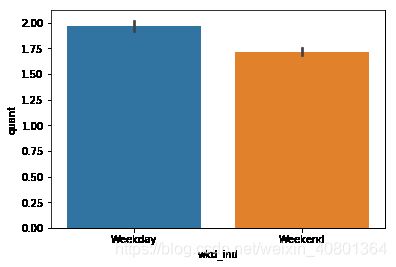
sns.barplot(x='wkd_ind',y='revenue',data =UNIQLO1)
C:\Users\LYY\Anaconda3\lib\site-packages\scipy\stats\stats.py:1713: FutureWarning: Using a non-tuple sequence for multidimensional indexing is deprecated; use `arr[tuple(seq)]` instead of `arr[seq]`. In the future this will be interpreted as an array index, `arr[np.array(seq)]`, which will result either in an error or a different result.
return np.add.reduce(sorted[indexer] * weights, axis=axis) / sumval
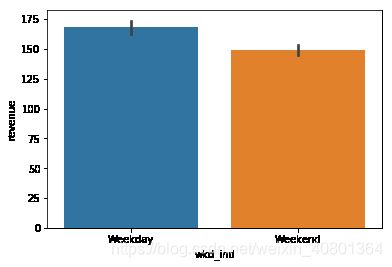
sns.barplot(x='wkd_ind',y='customer',data =UNIQLO1)
C:\Users\LYY\Anaconda3\lib\site-packages\scipy\stats\stats.py:1713: FutureWarning: Using a non-tuple sequence for multidimensional indexing is deprecated; use `arr[tuple(seq)]` instead of `arr[seq]`. In the future this will be interpreted as an array index, `arr[np.array(seq)]`, which will result either in an error or a different result.
return np.add.reduce(sorted[indexer] * weights, axis=axis) / sumval
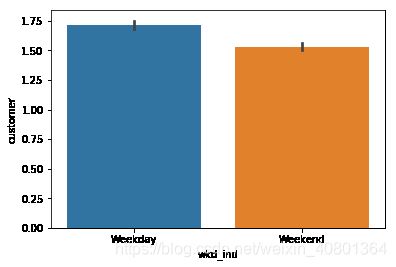
问题二:不同产品的销售情况是怎样的?顾客偏爱哪一种购买方式?
题目拆解:
- 不同产品即指product字段中不同类别的产品,销售情况即为销售额revenue,可生成柱状图进行可视化
- 购买方式只有channel是线上还是线下这一个指标,而顾客可以从不同性别gender_group、年龄段age_group、城市city三个维度进行分解,因此本问即为探究不同性别、年龄段和城市的顾客对线上、线下两种购买方式的偏好,可生成柱状图进行可视化的呈现
UNIQLO1.groupby(['product'])['revenue'].describe()
|
count |
mean |
std |
min |
25% |
50% |
75% |
max |
| product |
|
|
|
|
|
|
|
|
| T恤 |
10598.0 |
145.192002 |
154.288788 |
13.50 |
79.0 |
99.0 |
158.0 |
6636.00 |
| 当季新品 |
2534.0 |
233.095848 |
597.852857 |
19.00 |
76.0 |
111.0 |
197.0 |
12538.00 |
| 毛衣 |
806.0 |
304.752854 |
290.715612 |
13.00 |
149.0 |
199.0 |
396.0 |
4975.00 |
| 牛仔裤 |
1410.0 |
174.558496 |
238.760626 |
13.33 |
59.0 |
79.0 |
199.0 |
2087.00 |
| 短裤 |
1691.0 |
63.563501 |
55.631526 |
10.00 |
37.0 |
40.0 |
77.0 |
676.00 |
| 袜子 |
2048.0 |
62.368828 |
51.153136 |
10.00 |
27.0 |
52.0 |
79.0 |
595.36 |
| 裙子 |
629.0 |
218.287409 |
172.449212 |
10.00 |
99.0 |
197.0 |
237.0 |
1442.00 |
| 运动 |
975.0 |
121.087528 |
142.760425 |
18.00 |
39.0 |
78.0 |
149.0 |
1257.00 |
| 配件 |
1571.0 |
283.058657 |
398.768068 |
29.00 |
99.0 |
149.0 |
298.0 |
4187.00 |
plt.rcParams['font.sans-serif'] = 'SimHei'
plt.rcParams['axes.unicode_minus'] = False
sns.barplot(x = 'product',y = 'revenue',data = UNIQLO1)
C:\Users\LYY\Anaconda3\lib\site-packages\scipy\stats\stats.py:1713: FutureWarning: Using a non-tuple sequence for multidimensional indexing is deprecated; use `arr[tuple(seq)]` instead of `arr[seq]`. In the future this will be interpreted as an array index, `arr[np.array(seq)]`, which will result either in an error or a different result.
return np.add.reduce(sorted[indexer] * weights, axis=axis) / sumval
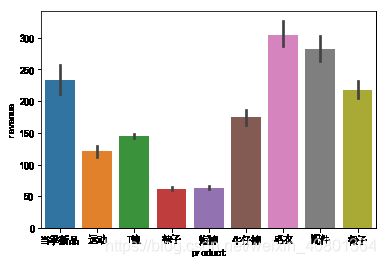
1.从不同性别gender_group
plt.rcParams['font.sans-serif'] = 'SimHei'
plt.rcParams['axes.unicode_minus'] = False
sns.countplot(y='gender_group',hue='channel',data=UNIQLO1,order=UNIQLO1['gender_group'].value_counts().index)
plt.tick_params(labelsize=20)
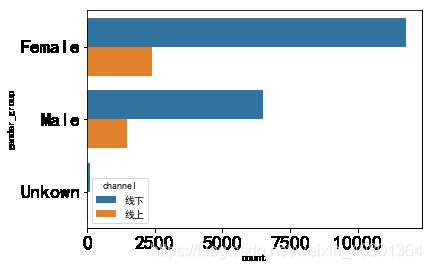
plt.rcParams['font.sans-serif'] = 'SimHei'
plt.rcParams['axes.unicode_minus'] = False
sns.countplot(y='age_group',hue='channel',data=UNIQLO1,order=UNIQLO1['age_group'].value_counts().index)
plt.tick_params(labelsize=20)
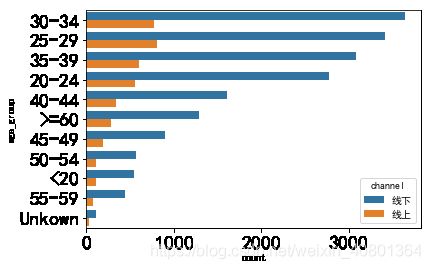
plt.rcParams['font.sans-serif'] = 'SimHei'
plt.rcParams['axes.unicode_minus'] = False
sns.countplot(y='city',hue='channel',data=UNIQLO1,order=UNIQLO1['city'].value_counts().index)
plt.tick_params(labelsize=20)
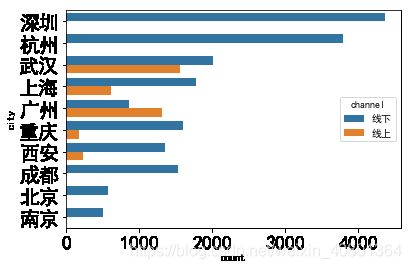
问题三:销售额和产品成本之间的关系怎么样?
题目拆解:
- 每单顾客的总销售额为revenue,根据数量quant可以计算出单件产品销售金额,又已知单件产品成本为unit_cost和其类别product。
- 思路一:单件产品销售额-成本为利润margin,margin是如何分布的?是否存在亏本销售的产品?
- 思路二:探究实际销售额和产品成本之间的关系,即为求它们之间的相关,若成正相关,则产品成本越高,销售额越高,或许为高端商品;若成负相关,则成本越低,销售额越高,为薄利多销的模式。
- 还可以拆分得更细,探究不同城市和门店中成本和销售额的相关性。
UNIQLO1.head()
|
store_id |
city |
channel |
gender_group |
age_group |
wkd_ind |
product |
customer |
revenue |
order |
quant |
unit_cost |
| 0 |
658 |
深圳 |
线下 |
Female |
25-29 |
Weekday |
当季新品 |
4 |
796.0 |
4 |
4 |
59 |
| 1 |
146 |
杭州 |
线下 |
Female |
25-29 |
Weekday |
运动 |
1 |
149.0 |
1 |
1 |
49 |
| 2 |
70 |
深圳 |
线下 |
Male |
>=60 |
Weekday |
T恤 |
2 |
178.0 |
2 |
2 |
49 |
| 3 |
658 |
深圳 |
线下 |
Female |
25-29 |
Weekday |
T恤 |
1 |
59.0 |
1 |
1 |
49 |
| 4 |
229 |
深圳 |
线下 |
Male |
20-24 |
Weekend |
袜子 |
2 |
65.0 |
2 |
3 |
9 |
UNIQLO1['unit_revenue'] = (UNIQLO1['revenue']/UNIQLO1['quant'])
UNIQLO1['margin'] = (UNIQLO1['revenue']/UNIQLO1['quant']-UNIQLO1['unit_cost'])
C:\Users\LYY\Anaconda3\lib\site-packages\ipykernel_launcher.py:1: SettingWithCopyWarning:
A value is trying to be set on a copy of a slice from a DataFrame.
Try using .loc[row_indexer,col_indexer] = value instead
See the caveats in the documentation: http://pandas.pydata.org/pandas-docs/stable/indexing.html#indexing-view-versus-copy
"""Entry point for launching an IPython kernel.
C:\Users\LYY\Anaconda3\lib\site-packages\ipykernel_launcher.py:2: SettingWithCopyWarning:
A value is trying to be set on a copy of a slice from a DataFrame.
Try using .loc[row_indexer,col_indexer] = value instead
See the caveats in the documentation: http://pandas.pydata.org/pandas-docs/stable/indexing.html#indexing-view-versus-copy
UNIQLO1.head()
|
store_id |
city |
channel |
gender_group |
age_group |
wkd_ind |
product |
customer |
revenue |
order |
quant |
unit_cost |
unit_revenue |
profit |
margin |
| 0 |
658 |
深圳 |
线下 |
Female |
25-29 |
Weekday |
当季新品 |
4 |
796.0 |
4 |
4 |
59 |
199.000000 |
140.000000 |
140.000000 |
| 1 |
146 |
杭州 |
线下 |
Female |
25-29 |
Weekday |
运动 |
1 |
149.0 |
1 |
1 |
49 |
149.000000 |
100.000000 |
100.000000 |
| 2 |
70 |
深圳 |
线下 |
Male |
>=60 |
Weekday |
T恤 |
2 |
178.0 |
2 |
2 |
49 |
89.000000 |
40.000000 |
40.000000 |
| 3 |
658 |
深圳 |
线下 |
Female |
25-29 |
Weekday |
T恤 |
1 |
59.0 |
1 |
1 |
49 |
59.000000 |
10.000000 |
10.000000 |
| 4 |
229 |
深圳 |
线下 |
Male |
20-24 |
Weekend |
袜子 |
2 |
65.0 |
2 |
3 |
9 |
21.666667 |
12.666667 |
12.666667 |
sns.distplot(UNIQLO1['margin'])
C:\Users\LYY\Anaconda3\lib\site-packages\scipy\stats\stats.py:1713: FutureWarning: Using a non-tuple sequence for multidimensional indexing is deprecated; use `arr[tuple(seq)]` instead of `arr[seq]`. In the future this will be interpreted as an array index, `arr[np.array(seq)]`, which will result either in an error or a different result.
return np.add.reduce(sorted[indexer] * weights, axis=axis) / sumval
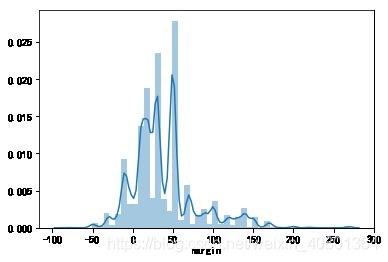
销售产品的利润分布(类别)
- 牛仔裤最可能成为亏本销售产品,部分的毛衣和T恤也可能存在亏本销售;
- T恤的盈利的波动较大,-50到200
- 裙子和配件是盈利比较高的两类商品
sns.boxplot(x='margin',y = 'product',data = UNIQLO1)
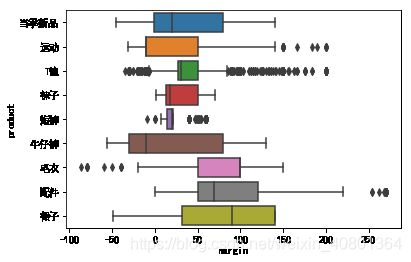
销售产品的利润分布(城市)
sns.boxplot(x='margin',y = 'city',data = UNIQLO1)
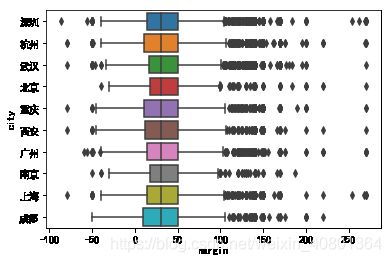
sns.boxplot(x='margin',y = 'channel',data = UNIQLO1)
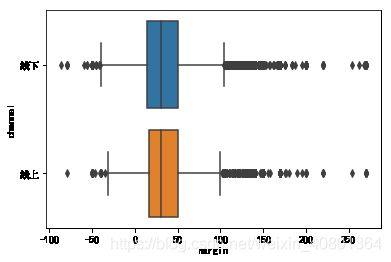
UNIQLO1[['unit_revenue','unit_cost']].corr()
|
unit_revenue |
unit_cost |
| unit_revenue |
1.000000 |
0.503499 |
| unit_cost |
0.503499 |
1.000000 |
sns.heatmap(UNIQLO1[['unit_revenue','unit_cost']].corr())
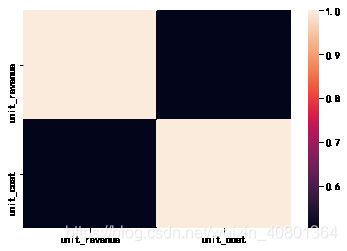
还可以拆分得更细,探究不同城市和门店中成本和销售额的相关性
UNIQLO1.groupby(['city'])['unit_revenue','unit_cost'].corr(min_periods=1)
|
|
unit_revenue |
unit_cost |
| city |
|
|
|
| 上海 |
unit_revenue |
1.000000 |
0.475711 |
| unit_cost |
0.475711 |
1.000000 |
| 北京 |
unit_revenue |
1.000000 |
0.474852 |
| unit_cost |
0.474852 |
1.000000 |
| 南京 |
unit_revenue |
1.000000 |
0.550571 |
| unit_cost |
0.550571 |
1.000000 |
| 广州 |
unit_revenue |
1.000000 |
0.446615 |
| unit_cost |
0.446615 |
1.000000 |
| 成都 |
unit_revenue |
1.000000 |
0.514083 |
| unit_cost |
0.514083 |
1.000000 |
| 杭州 |
unit_revenue |
1.000000 |
0.529296 |
| unit_cost |
0.529296 |
1.000000 |
| 武汉 |
unit_revenue |
1.000000 |
0.536779 |
| unit_cost |
0.536779 |
1.000000 |
| 深圳 |
unit_revenue |
1.000000 |
0.487396 |
| unit_cost |
0.487396 |
1.000000 |
| 西安 |
unit_revenue |
1.000000 |
0.523069 |
| unit_cost |
0.523069 |
1.000000 |
| 重庆 |
unit_revenue |
1.000000 |
0.504232 |
| unit_cost |
0.504232 |
1.000000 |
sns.heatmap(UNIQLO1.groupby(['city'])['unit_revenue','unit_cost'].corr())
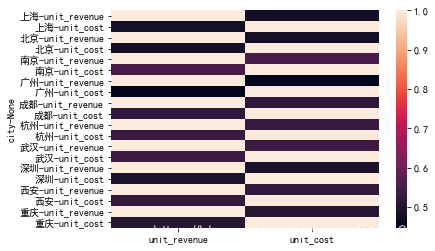
不同城市成本和销售额的相关性比较一致,其中南京相关性稍微强一些












